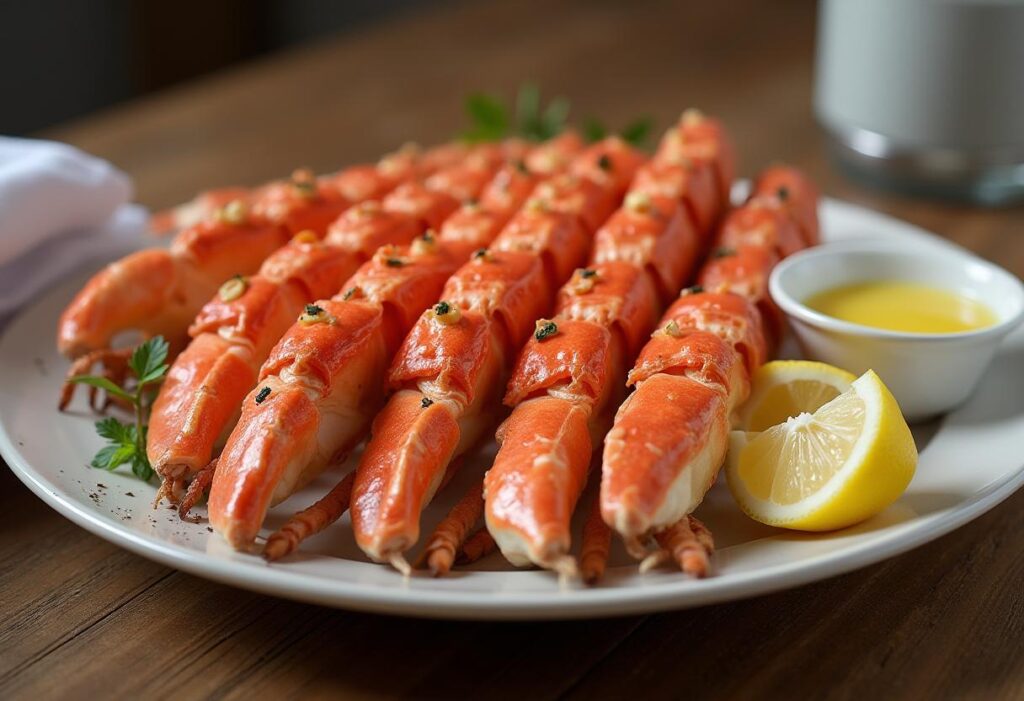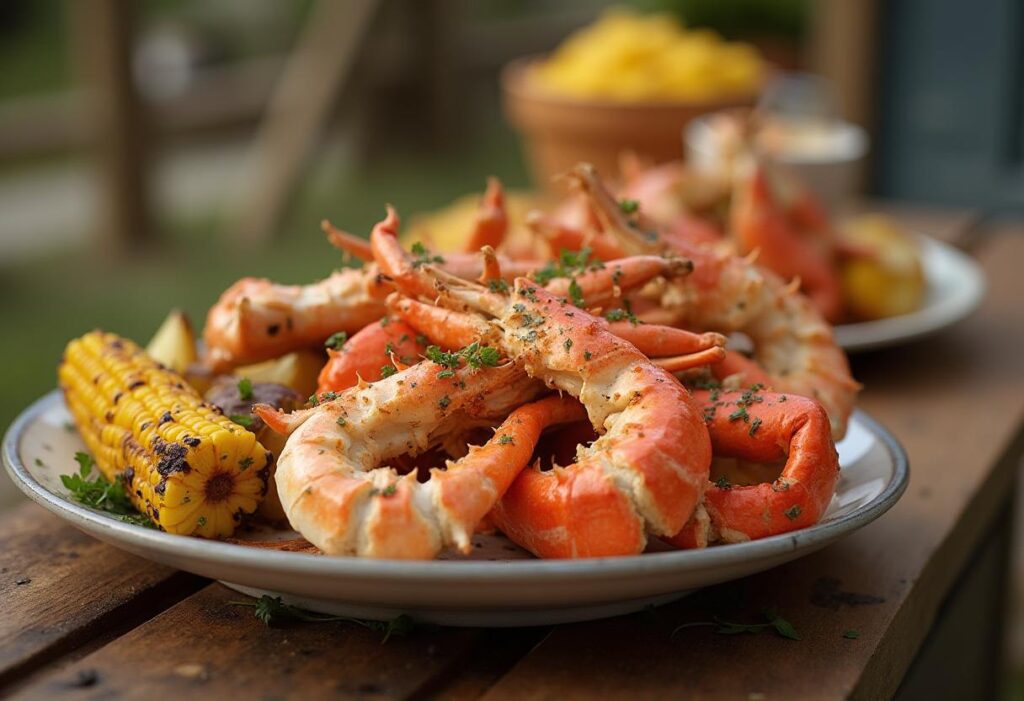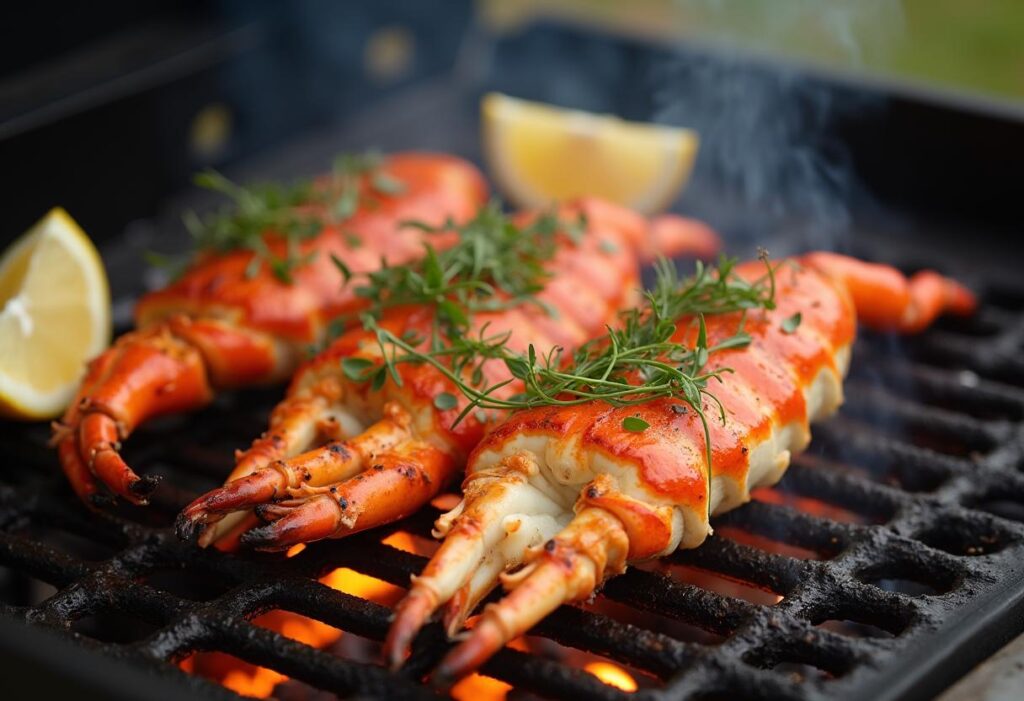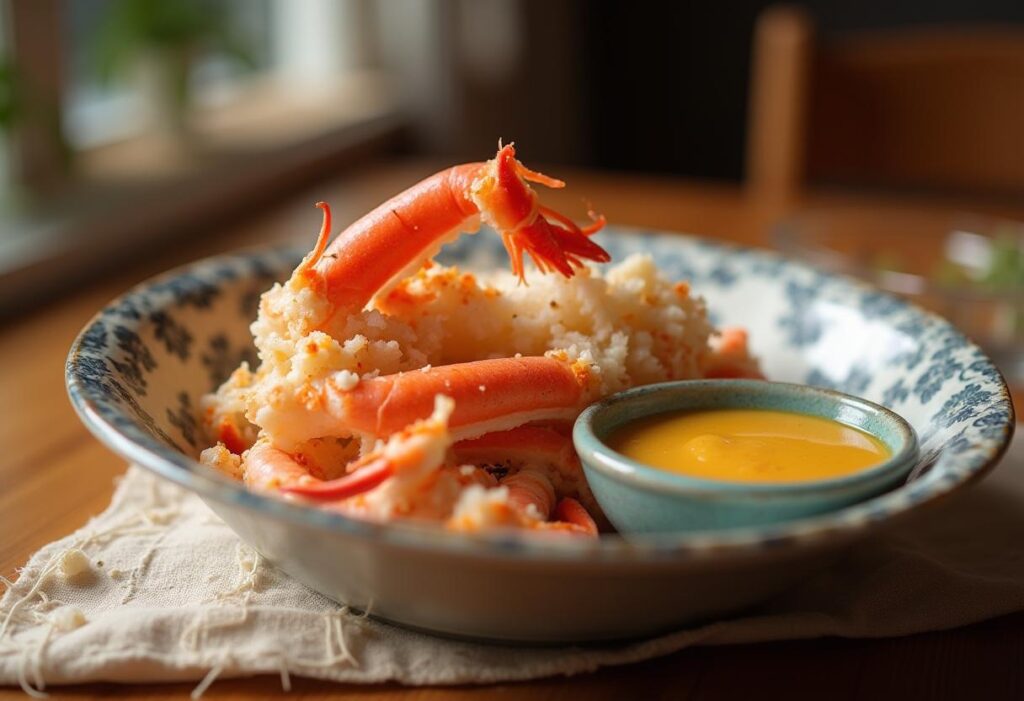
Snow crab legs are a seafood delicacy that many people enjoy for their sweet, tender meat and impressive presentation. Whether you’re new to this tasty treat or a seasoned pro looking to refine your technique, this article will cover everything you need to know about snow crab legs. We’ll dive into the various types, the nutritional benefits, cooking methods, and even some creative recipes.
Table of contents
Introduction to Snow Crab Legs
What Are Snow Crab Legs?
Snow crab legs come from crabs found in colder waters like the North Atlantic and Pacific Oceans. Known for their delicate, sweet meat, these crabs have long, slender legs that are easier to crack open than other types. Often sold pre-cooked or frozen, they require minimal preparation. Whether at home or in a restaurant, snow crab legs offer a delicious and enjoyable seafood experience.
Origin and Habitat of Snow Crabs
Snow crabs thrive in cold waters, particularly in the Bering Sea, North Atlantic, and parts of the Pacific Ocean. They are vital to the marine ecosystem, feeding on smaller crustaceans. The Alaskan and Canadian snow crabs are the most commonly harvested species. Their hardiness in frigid temperatures makes them especially sought after during winter, and commercial fisheries ensure a steady year-round supply to meet the high demand for their sweet, tender meat.
Nutritional Value and Health Benefits

Rich Protein Source
Snow crab legs are not just delicious; they’re also packed with protein, which is essential for building and repairing tissues in your body. One of the best things about snow crab legs is that they offer a lean source of protein, making them an excellent choice for those looking to maintain a healthy diet. A typical serving of snow crab legs provides a solid amount of protein without the heavy calories that come with many other animal-based protein sources.
In fact, just a 3-ounce portion of snow crab legs can provide up to 19 grams of protein! So, if you’re looking to boost your protein intake without going overboard on calories, snow crab legs are a great addition to your meals.
Low in Calories and Fat
Another reason why snow crab legs stand out is that they’re relatively low in calories and fat. With only about 80 to 100 calories per 3-ounce serving, snow crab legs offer a great alternative to heavier, more calorie-dense foods. Plus, they’re naturally low in fat, making them a suitable choice for anyone watching their fat intake.
This makes snow crab legs an ideal food for those on a weight management plan or anyone looking to keep their meals light yet satisfying. They’re filling and flavorful without the excess baggage, so you can enjoy them guilt-free!
High in Omega-3 Fatty Acids
When it comes to healthy fats, snow crab legs are an excellent source of omega-3 fatty acids. These healthy fats are known for their role in promoting heart health, reducing inflammation, and improving brain function. Eating snow crab legs regularly can contribute to your overall intake of omega-3s, which are essential for maintaining a well-rounded diet.
Including omega-3-rich foods like snow crab legs in your meals can help lower bad cholesterol levels and reduce your risk of heart disease, making them a smart choice for long-term health.
Vitamins and Minerals
Snow crab legs also come with a variety of vitamins and minerals that support various bodily functions. For instance, they are a great source of vitamin B12, which is crucial for the production of red blood cells and proper nerve function. Additionally, snow crab legs contain zinc, which helps strengthen your immune system, and selenium, a powerful antioxidant that supports thyroid function and protects cells from damage.
These micronutrients, combined with their other health benefits, make snow crab legs not only a tasty treat but also a nutritional powerhouse.
Types of Snow Crab Legs
Alaskan Snow Crab
Alaskan snow crab legs come from the cold waters of the Bering Sea. Known for their sweet, tender meat, these crabs are caught in large quantities during winter. Their distinct, slightly briny flavor makes them a favorite among seafood lovers. Whether steamed, boiled, or grilled, Alaskan snow crab legs offer a delicious and satisfying meal.
The legs of Alaskan snow crabs are typically long and slender, and their meat is relatively easy to extract. Due to their popularity, these snow crab legs are widely available in both grocery stores and restaurants, making them the go-to choice for many seafood enthusiasts.
Canadian Snow Crab
On the other hand, Canadian snow crab comes from the cold waters of the North Atlantic, primarily around Newfoundland and the Gulf of St. Lawrence. These crabs tend to have a slightly different flavor profile compared to their Alaskan counterparts. Canadian snow crab legs are often described as more delicate and slightly sweeter, with a smooth texture that melts in your mouth.
Despite the differences in flavor, Canadian snow crab legs are just as tender and delicious, making them a fantastic option for any snow crab lover. Plus, they’re typically a bit more affordable, so if you’re looking to try snow crab legs on a budget, Canadian snow crab is worth considering.
Differences in Taste and Texture
While both Alaskan and Canadian snow crab legs are delicious, the main differences between the two lie in their taste and texture. Alaskan snow crab legs tend to have a more pronounced briny flavor, likely due to the colder, more saline waters they inhabit. In contrast, Canadian snow crab legs are often sweeter and milder, with a slightly firmer texture.
These subtle differences make each type unique, so if you haven’t tried both, it’s definitely worth sampling both varieties to see which one you prefer. Whether you choose Alaskan or Canadian snow crab legs, you’re in for a treat!
How to Purchase Snow Crab Legs
Selecting Quality Crab Legs
When selecting snow crab legs, look for firmness and fresh, translucent meat. Avoid legs with signs of freezer burn or discoloration. If frozen, ensure they’ve been stored properly and check the packaging for any damage. It’s also important to choose sustainably sourced crabs, as many fisheries now promote eco-friendly practices. This helps protect marine ecosystems and ensures the continued availability of these delicious crabs.
Where to Buy Snow Crab Legs
Snow crab legs can be found at various retailers, both online and in-person. For those who prefer shopping in-store, large supermarkets, seafood markets, and warehouse clubs often carry frozen or pre-cooked snow crab leg. Online seafood shops are also a great option for buying premium-quality crabs delivered right to your door.
If you’re looking for fresh crab legs, your best bet would be to visit a specialized seafood market. Keep in mind that fresh snow crab leg will often cost a bit more than frozen, but the taste and texture can be worth the extra investment if you’re aiming for a high-end seafood experience.
Understanding Pricing and Portions
The cost of snow crab leg varies depending on factors like the season, where they’re sourced from, and their size. On average, you can expect to pay anywhere between $15 to $30 per pound. When buying snow crab leg, it’s also important to keep in mind the number of people you’re serving. Typically, a 1-pound serving will provide 2 to 3 pieces of crab leg, which is perfect for a single person or a light appetizer.
If you’re hosting a larger gathering, you may want to purchase a few more pounds to ensure everyone gets enough. And don’t forget to consider the cost of accompanying sides, like garlic butter or steamed vegetables, which complement snow crab leg beautifully.
Preparation and Cooking Methods
Thawing Frozen Crab Legs
Before cooking snow crab leg, it’s important to properly thaw them if they’re frozen. To do so, place the crab legs in the refrigerator for several hours, or overnight, so they can thaw slowly. This helps preserve their flavor and texture. If you’re short on time, you can use the cold water method. Simply place the crab legs in a sealed plastic bag, submerge them in cold water, and let them thaw for about 30 minutes.
Avoid thawing snow crab leg in hot water, as this can cause the meat to become rubbery or tough. The key is to allow them to thaw gradually so they retain their natural sweetness.
Steaming Snow Crab Legs
One of the best methods for cooking snow crab leg is steaming. Steaming helps preserve the natural juices and delicate flavor of the crab meat. To steam snow crab leg, fill a large pot with about an inch of water, and add a steaming rack or basket. Bring the water to a boil, then place the crab legs on the rack. Cover and steam for 5-7 minutes, depending on their size.
If you prefer extra flavor, you can add herbs, garlic, or lemon to the water to infuse the crab legs with an aromatic touch. Once they’re done, the meat should easily pull away from the shells, and you can enjoy them with your favorite dipping sauce.
Boiling Techniques
Boiling snow crab leg is another popular method, especially if you’re cooking a larger batch. Begin by filling a large pot with water, then bring it to a boil. Add a generous amount of salt to the water (about 1-2 tablespoons per quart) to enhance the flavor of the crab legs. Once the water is boiling, carefully add the crab legs and cook for 4-6 minutes.
The water should be at a full boil before adding the crab legs to ensure even cooking. Be cautious not to overcook the snow crab leg, as they can lose their tenderness and sweetness. Once cooked, drain the crab legs and serve with melted butter or your favorite dipping sauce.
Grilling Snow Crab Legs
For a smoky, charred flavor, grill snow crab leg by brushing them with olive oil or butter, then seasoning with your favorite spices. Preheat the grill to medium-high heat and cook the crab legs for 4-5 minutes on each side. Grilling adds a crispy texture to the exterior, contrasting the tender meat inside. For extra flavor, squeeze fresh lemon juice over the crab before serving.
Baking and Roasting
Baking or roasting snow crab leg is another great method if you’re looking for convenience. Simply preheat your oven to 375°F (190°C), place the crab legs on a baking sheet, and cover them with aluminum foil to lock in moisture. Bake for about 10-12 minutes, or until the meat is heated through. If you want a crispy finish, remove the foil during the last few minutes of baking.
Serving Suggestions and Dips
Once your snow crab leg are cooked to perfection, it’s time to serve them up! A classic option is to pair them with melted garlic butter for dipping. You can also serve them with a tangy lemon-butter sauce or a spicy aioli for a kick of flavor.
For a complete meal, serve the crab legs alongside steamed vegetables, roasted potatoes, or a fresh salad. Snow crab leg are incredibly versatile, so feel free to get creative with your sides and dips!

Popular Snow Crab Legs Recipes
Classic Garlic Butter Snow Crab Legs
One of the most popular ways to enjoy snow crab les is by pairing them with garlic butter. The rich, savory flavor of the butter complements the delicate sweetness of the crab meat perfectly. To make this dish, simply melt butter with minced garlic, lemon juice, and a pinch of seasoning. Once your snow crab leg are cooked—whether steamed, boiled, or grilled—drizzle the garlic butter sauce over them for an irresistible treat.
This classic recipe is a hit at parties, seafood feasts, and holiday dinners. It’s easy to prepare, yet feels indulgent and luxurious, making it a perfect way to impress guests or enjoy a special meal at home.
Snow Crab Legs with Lemon and Old Bay
For a flavorful kick, toss steamed snow crab leg with melted butter, fresh lemon juice, and Old Bay seasoning. The zesty lemon and spicy seasoning complement the sweetness of the crab. Serve with coleslaw, corn on the cob, or crispy fries for a classic seafood boil. This dish is perfect when you want to add extra flavor to your snow crab leg.
Snow Crab Legs with Garlic Parmesan
For a twist on the traditional garlic butter, try adding parmesan cheese for a creamy, cheesy kick. This recipe involves coating the cooked snow crab leg in a garlic, butter, and parmesan mixture. After a quick broil in the oven to melt the cheese, the result is a cheesy, garlicky indulgence that takes your snow crab leg to the next level.
This variation is perfect for those who enjoy richer, more decadent flavors. Pair it with a simple salad or some sautéed spinach to balance the richness of the dish. The combination of garlic, butter, and parmesan is always a crowd-pleaser.
Snow Crab Legs with Herb Sauce
If you’re looking for something a little lighter, an herb sauce can be the perfect complement to snow crab leg. A mix of fresh herbs like parsley, basil, and thyme, combined with olive oil and lemon juice, creates a refreshing sauce that adds brightness without overpowering the delicate crab flavor.
This herb sauce is especially great for grilled or baked snow crab leg. It can also be used as a dipping sauce for those who want a bit of freshness with every bite. For a healthy, flavorful option, this recipe will not disappoint.

Conclusion
Snow crab leg offer a delicious and versatile seafood experience, whether you steam, boil, grill, or bake them. By selecting high-quality crab legs and choosing the right cooking method, you can enjoy their sweet, tender meat in various flavorful dishes. From classic garlic butter to tangy lemon sauces, there’s no shortage of ways to savor this delicacy. Give snow crab leg a try for your next meal, and explore more recipe ideas to complement them!
For a unique twist on seafood, try the Crab Brulee Recipe. This dish combines the sweet, tender meat of crab with the crispy, caramelized sugar topping, offering a rich and indulgent flavor. It’s a great way to enjoy crab in a new and exciting way.
FAQ
How to Cook Snow Crab Legs?
Cooking snow crab leg is simple and quick. You can steam, boil, grill, or bake them. For steaming, place the crab legs in a steamer basket over boiling water and steam for about 5-7 minutes. If boiling, add the legs to salted boiling water and cook for 4-6 minutes. For grilling, brush them with butter or oil and grill for 4-5 minutes per side. Baking can be done by covering with foil at 375°F for 10-12 minutes.
How to Prepare Snow Crab Legs?
Before cooking, prepare snow crab leg by thawing them if frozen. The best way is to let them thaw overnight in the fridge. If in a hurry, you can use the cold water method. After thawing, use a crab cracker to break open the shells and enjoy the sweet, tender meat inside.
How Long to Boil Frozen Snow Crab Legs?
To boil frozen snow crab leg, bring a large pot of salted water to a boil. Once boiling, add the frozen crab legs and cook for about 6-8 minutes. Since they’re already pre-cooked, you only need to heat them through.
How to Cook Frozen Snow Crab Legs?
Cooking frozen snow crab leg is easy. Whether steaming, boiling, or grilling, simply add a few extra minutes to the cook time. Steaming takes about 8-10 minutes, boiling around 6-8 minutes, and grilling typically requires 6-8 minutes per side. Just make sure the crab is heated all the way through before serving.
